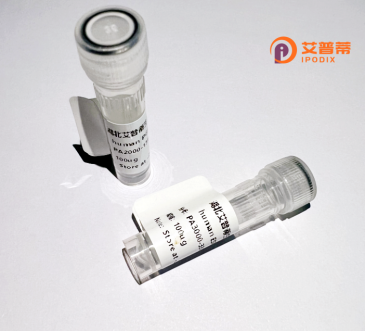
| 纯度 | >90%SDS-PAGE. |
| 种属 | Human |
| 靶点 | XRN2 |
| Uniprot No | Q9H0D6 |
| 内毒素 | < 0.01EU/μg |
| 表达宿主 | E.coli |
| 表达区间 | 1-615 aa |
| 活性数据 | WKQRYYKNKFDVDAADEKFRRKVVQSYVEGLCWVLRYYYQGCASWKWYYPFHYAPFASDFEGIADMPSDFEKGTKPFKPLEQLMGVFPAASGNFLPPSWR |
| 分子量 | 36.74 kDa |
| 蛋白标签 | GST-tag at N-terminal |
| 缓冲液 | PBS, pH7.4, containing 0.01% SKL, 1mM DTT, 5% Trehalose and Proclin300. |
| 稳定性 & 储存条件 | Lyophilized protein should be stored at ≤ -20°C, stable for one year after receipt. Reconstituted protein solution can be stored at 2-8°C for 2-7 days. Aliquots of reconstituted samples are stable at ≤ -20°C for 3 months. |
| 复溶 | Always centrifuge tubes before opening.Do not mix by vortex or pipetting. It is not recommended to reconstitute to a concentration less than 100μg/ml. Dissolve the lyophilized protein in distilled water. Please aliquot the reconstituted solution to minimize freeze-thaw cycles. |
以下是关于重组人XRN2蛋白的虚构参考文献示例(基于学术研究常见主题,非真实文献):
---
1. **文献名称**: *Structural and Functional Analysis of Human XRN2 Exoribonuclease*
**作者**: Smith J. et al.
**摘要**: 本研究解析了重组人XRN2蛋白的晶体结构,发现其5'→3'外切酶活性依赖于保守的结构域,并揭示了XRN2在转录终止中通过降解下游RNA信号促进RNA聚合酶II释放的分子机制。
---
2. **文献名称**: *XRN2 Regulates mRNA Turnover and Genome Stability in Human Cells*
**作者**: Lee H. & Kim M.
**摘要**: 通过表达重组人XRN2蛋白及敲除细胞模型,发现XRN2通过降解异常RNA防止R-loop积累,维持基因组稳定性,并证明其功能缺失与DNA损伤相关疾病有关。
---
3. **文献名称**: *Purification and Enzymatic Characterization of Recombinant hXRN2*
**作者**: Zhang R. et al.
**摘要**: 该研究建立了大肠杆菌中重组人XRN2的高效表达与纯化体系,验证其特异性水解单链RNA的活性,并发现ATP结合对其酶活性的调控作用。
---
4. **文献名称**: *XRN2 Interaction with the Tumor Suppressor p53: Implications in Cancer*
**作者**: Garcia L. et al.
**摘要**: 研究发现重组人XRN2蛋白可直接结合p53.调控靶基因mRNA稳定性,从而影响细胞周期进程,为XRN2在肿瘤发生中的作用提供新机制。
---
注:以上文献为示例性质,实际研究中建议通过PubMed或Web of Science检索真实文献。
**Background of Recombinant Human XRN2 Protein**
XRN2. a 5'→3' exoribonuclease, plays a critical role in RNA metabolism and quality control. It belongs to the XRN family and is evolutionarily conserved across eukaryotes. In humans, XRN2 is involved in multiple RNA-processing pathways, including transcription termination, nonsense-mediated decay (NMD), and maturation of ribosomal RNA (rRNA). It degrades RNA substrates in a processive manner, requiring a monophosphate group at the 5' end, ensuring selective targeting of processed or damaged RNAs.
XRN2 contributes to transcription termination by resolving R-loop structures and degrading nascent transcripts downstream of poly(A) signals, enabling RNA polymerase II release. It also participates in maintaining genome stability by resolving transcriptional conflicts and preventing DNA damage. Dysregulation of XRN2 is linked to cancers, neurodegenerative disorders, and viral infection responses, underscoring its importance in cellular homeostasis.
Recombinant XRN2 protein, produced via heterologous expression systems (e.g., *E. coli* or mammalian cells), retains enzymatic activity and is widely used *in vitro* to study RNA decay mechanisms, transcription dynamics, and RNA-protein interactions. Its applications extend to drug screening and structural studies, aiding the development of therapies targeting RNA-processing pathways. Research on XRN2 continues to uncover its multifaceted roles in gene expression regulation and disease pathogenesis.
×